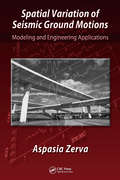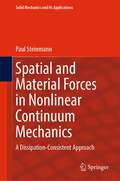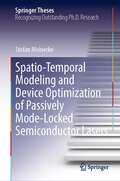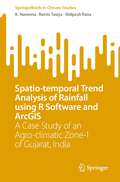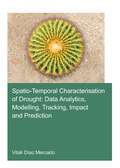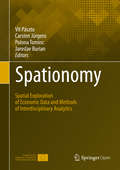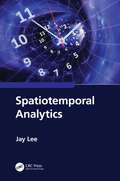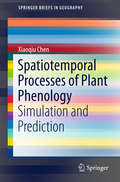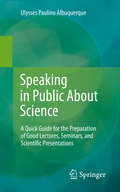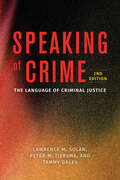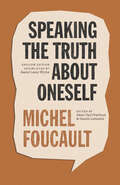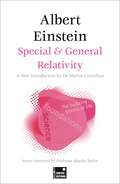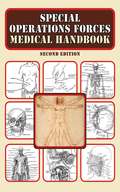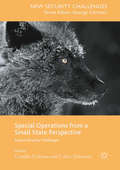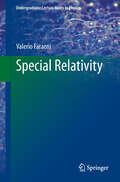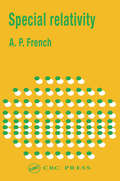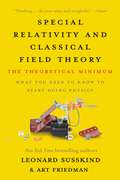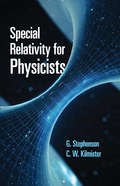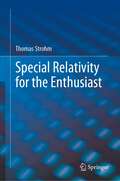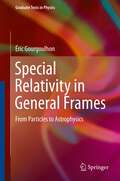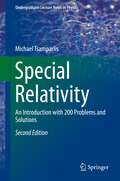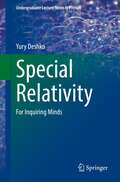- Table View
- List View
Spatial Variation of Seismic Ground Motions: Modeling and Engineering Applications (Advances in Engineering Series)
by Aspasia ZervaThe spatial variation of seismic ground motions denotes the differences in the seismic time histories at various locations on the ground surface. This text focuses on the spatial variability of the motions that is caused by the propagation of the waveforms from the earthquake source through the earth strata to the ground surface, and it brings toge
Spatial and Material Forces in Nonlinear Continuum Mechanics: A Dissipation-Consistent Approach (Solid Mechanics and Its Applications #272)
by Paul SteinmannThis monograph details spatial and material vistas on non-linear continuum mechanics in a dissipation-consistent approach. Thereby, the spatial vista renders the common approach to nonlinear continuum mechanics and corresponding spatial forces, whereas the material vista elaborates on configurational mechanics and corresponding material or rather configurational forces. Fundamental to configurational mechanics is the concept of force. In analytical mechanics, force is a derived object that is power conjugate to changes of generalised coordinates. For a continuum body, these are typically the spatial positions of its continuum points. However, if in agreement with the second law, continuum points, e.g. on the boundary, may also change their material positions. Configurational forces are then power conjugate to these configurational changes. A paradigm is a crack tip, i.e. a singular part of the boundary changing its position during crack propagation, with the related configurational force, typically the J-integral, driving its evolution, thereby consuming power, typically expressed as the energy release rate. Taken together, configurational mechanics is an unconventional branch of continuum physics rationalising and unifying the tendency of a continuum body to change its material configuration. It is thus the ideal formulation to tackle sophisticated problems in continuum defect mechanics. Configurational mechanics is entirely free of restrictions regarding geometrical and constitutive nonlinearities and offers an accompanying versatile computational approach to continuum defect mechanics. In this monograph, I present a detailed summary account of my approach towards configurational mechanics, thereby fostering my view that configurational forces are indeed dissipation-consistent to configurational changes.
Spatio-Temporal Modeling and Device Optimization of Passively Mode-Locked Semiconductor Lasers (Springer Theses)
by Stefan MeineckeThis thesis investigates passively mode-locked semiconductor lasers by numerical methods. The understanding and optimization of such devices is crucial to the advancement of technologies such as optical data communication and dual comb spectroscopy. The focus of the thesis is therefore on the development of efficient numerical models, which are able both to perform larger parameter studies and to provide quantitative predictions. Along with that, visualization and evaluation techniques for the rich spatio-temporal laser dynamics are developed; these facilitate the physical interpretation of the observed features.The investigations in this thesis revolve around two specific semiconductor devices, namely a monolithically integrated three-section tapered quantum-dot laser and a V-shaped external cavity laser. In both cases, the simulations closely tie in with experimental results, which have been obtained in collaboration with the TU Darmstadt and the ETH Zurich. Based on the successful numerical reproduction of the experimental findings, the emission dynamics of both lasers can be understood in terms of the cavity geometry and the active medium dynamics. The latter, in particular, highlights the value of the developed simulation tools, since the fast charge-carrier dynamics are generally not experimentally accessible during mode-locking operation. Lastly, the numerical models are used to perform laser design explorations and thus to derive recommendations for further optimizations.
Spatio-temporal Trend Analysis of Rainfall using R Software and ArcGIS: A Case Study of an Agro-climatic Zone-1 of Gujarat, India (SpringerBriefs in Climate Studies)
by K. Naveena Ramiz Tasiya Shilpesh RanaThis book aims to provide an advanced R software approach that can carry out rainfall trend analysis using Mann-Kendall and Sen’s slope estimator tests. The research study follows a systematic approach while utilizing R software as it can greatly facilitate the analysis of rainfall trends. About 30 stations located in the study area and 41 to 50 years’ time series were selected for the purpose of analysis. The data for the research was collected from the State Water Data Centre (SWDC) in Gujarat, Indian Meteorological Department (IMD) in Pune, DAAC (NASA), and ESRI. Cluster analysis has been performed to analyze the variability of the mean rainfall. The stations have been divided into 2 clusters with 17 and 13 stations in each cluster which significantly differ from each other. This book is aimed at researchers, scientists and government organizations working in the field of climate change.
Spatio-temporal characterisation of drought: data analytics, modelling, tracking, impact and prediction (IHE Delft PhD Thesis Series)
by Vitali Diaz MercadoStudies of drought have increased in light of new data availability and advances in spatio-temporal analysis. However, the following gaps still need to be filled: 1) methods to characterise drought that explicitly consider its spatio-temporal features, such as spatial extent (area) and pathway; 2) methods to monitor and predict drought that include the above-mentioned characteristics and 3) approaches for visualising and analysing drought characteristics to facilitate interpretation of its variation. This research aims to explore, analyse and propose improvements to the spatio-temporal characterisation of drought. Outcomes provide new perspectives towards better prediction. The following objectives were proposed. 1) Improve the methodology for characterising drought based on the phenomenon’s spatial features. 2) Develop a visual approach to analysing drought variations. 3) Develop a methodology for spatial drought tracking. 4) Explore machine learning (ML) techniques to predict crop-yield responses to drought. The four objectives were addressed and results are presented. Finally, a scope was formulated for integrating ML and the spatio-temporal analysis of drought. Proposed scope opens a new area of potential for drought prediction (i.e. predicting spatial drought tracks and areas). It is expected that the drought tracking and prediction method will help populations cope with drought and its severe impacts.
Spationomy: Spatial Exploration of Economic Data and Methods of Interdisciplinary Analytics
by Carsten Jürgens Vít Pászto Polona Tominc Jaroslav BurianThis open access book is based on "Spationomy – Spatial Exploration of Economic Data", an interdisciplinary and international project in the frame of ERASMUS+ funded by the European Union. The project aims to exchange interdisciplinary knowledge in the fields of economics and geomatics. For the newly introduced courses, interdisciplinary learning materials have been developed by a team of lecturers from four different universities in three countries. In a first study block, students were taught methods from the two main research fields. Afterwards, the knowledge gained had to be applied in a project. For this international project, teams were formed, consisting of one student from each university participating in the project. The achieved results were presented in a summer school a few months later. At this event, more methodological knowledge was imparted to prepare students for a final simulation game about spatial and economic decision making. In a broader sense, the chapters will present the methodological background of the project, give case studies and show how visualisation and the simulation game works.
Spatiotemporal Analytics
by Jay LeeThis book introduces readers to spatiotemporal analytics that are extended from spatial statistics. Spatiotemporal analytics help analysts to quantitatively recognize and evaluate the spatial patterns and their temporal trends of a set of geographic events or objects. Spatiotemporal analyses are very important in geography, environmental sciences, economy, and many other domains. Spatiotemporal Analytics explains in very simple terms the concepts of spatiotemporal data and statistics, theories, and methods used. Each chapter introduces a case study as an example application for an in-depth learning process. The software used and the codes provided enable readers not only to learn statistics but also to use them effectively in their projects. • Provides a comprehensive understanding of spatiotemporal analytics to readers with minimum knowledge in statistics. • Written in simple, understandable language with step-by-step instructions. • Includes numerous examples for all theories and methods explained in the book covering a wide range of applications from different disciplines. • Each application includes a software code needed to follow the instructions. • Each chapter also has a set of prepared PowerPoint slides to help spatiotemporal analytics instructors explain the content. Undergraduate and graduate students who use Geographic Information Systems or study Geographical Information Science will find this book useful. The subject matter is also pertinent to an array of disciplines such as agriculture, anthropology, archaeology, architecture, biology, business administration and management, civic engineering, criminal justice, epidemiology, geography, geology, marketing, political science, and public health.
Spatiotemporal Processes of Plant Phenology: Simulation and Prediction (SpringerBriefs in Geography)
by Xiaoqiu ChenThis book deals with phenology, the study of recurring biological life cycle stages, and especially their timing and relationships with biotic and abiotic forces. Given the theoretical and methodological innovations involved, the chapters on defining spatiotemporal patterns of plant phenology and constructing daily temperature-based temporal/spatial models and process-based regional unified models will be of particular interest. Helping readers discover and explore plant phenology’s perspectives in terms of spatiotemporal patterns, processes and mechanisms, the book will also equip young scientists and graduate students to understand the causes of spatiotemporal variation in vegetation seasonality.
Speakable and Unspeakable in Quantum Mechanics
by J. S. BellThis book comprises all of John Bell's published and unpublished papers in the field of quantum mechanics, including two papers that appeared after the first edition was published. It also contains a preface written for the first edition, and an introduction by Alain Aspect that puts into context Bell's great contribution to the quantum philosophy debate. One of the leading expositors and interpreters of modern quantum theory, John Bell played a major role in the development of our current understanding of the profound nature of quantum concepts. First edition Hb (1987): 0-521-33495-0 First edition Pb (1988): 0-521-36869-3
Speaking in Public About Science
by Ulysses Paulino AlbuquerqueThis book introduces the basic techniques and methods traditionally used in speaking about science to the public. The public often has a very different perception and understanding of science, and this must be taken into account when communicating with the public. This volume covers methods of scientific discourse, oral communication, preparation of the presentation, techniques and use of visual resources, and exercises for perfecting the technique of speaking in public about science. Speaking in Public About Science: A Quick Guide for the Preparation of Good Lectures, Seminars, and Scientific Presentations is a concise yet comprehensive resource that will be of value to beginners and senior scholars and researchers.
Speaking of Crime: The Language of Criminal Justice (Chicago Series in Law and Society)
by Lawrence M. Solan Peter M. Tiersma Tammy GalesAn essential introduction to the use and misuse of language within the criminal justice system, updated for a new generation. Does everyone understand the Miranda warning? Why do people confess to a crime they did not commit? Can linguistic experts identify who wrote an anonymous threatening letter? Since its first publication, Speaking of Crime has been answering these questions. Introducing major topics and controversies at the intersection of language and law, Lawrence M. Solan, Peter M. Tiersma, and Tammy Gales apply multidisciplinary insights to examine the complex role of language within the US justice system. The second edition features in-depth discussions of recent cases, new legislation, and innovative research advances, and includes a new chapter on who interprets the laws governing linguistic contexts. Thoroughly updated and approachable, Speaking of Crime is a state-of-the-art survey that will be useful to scholars, students, and practitioners throughout the criminal justice system.
Speaking of Forms of Life: The Language of Conservation (Fascinating Life Sciences)
by Daniel Guevara Claudio CampagnaHumans pose an unprecedented threat to life in all its great diversity of forms. The human-induced extinction rate has been compared to “mass extinctions” of the past. But this language masks the fact that the crisis is due to voluntary, and thus, avoidable choices and actions. “Speaking of Forms of Life” shows that at the root of this crisis is the tragic inadequacy of the language predominantly used to represent and address what we are doing, including the language of “sustainable development,” “rights” for animals and the rest of nature, their “intrinsic value,” and conservation of species as “populations.” This talk alienates us from the other living things, from what they actually are, have and do, and it perpetuates the harm and loss. Campagna and Guevara compellingly argue, on rigorous but accessible grounds, that there is an alternative language to guide conservation, in confronting the radically urgent, ethical issues it faces. This is a language with which we are all familiar, mastered by naturalists, from Aristotle to Audubon. It articulates the primary value in life and the standard that must guide how human beings should live, as one form of life, among countless others. This book is a homecoming for those who practice conservation to, above all else, secure a creature’s ability to satisfy the necessities of its form of life.
Speaking the Truth about Oneself: Lectures at Victoria University, Toronto, 1982 (The Chicago Foucault Project)
by Michel FoucaultNow in paperback, this collection of Foucault’s lectures traces the historical formation and contemporary significance of the hermeneutics of the self. Just before the summer of 1982, French philosopher Michel Foucault gave a series of lectures at Victoria University in Toronto. In these lectures, which were part of his project of writing a genealogy of the modern subject, he is concerned with the care and cultivation of the self, a theme that becomes central to the second, third, and fourth volumes of his History of Sexuality. Foucault had always been interested in the question of how constellations of knowledge and power produce and shape subjects, and in the last phase of his life, he became especially interested not only in how subjects are formed by these forces but in how they ethically constitute themselves. In this lecture series and accompanying seminar, Foucault focuses on antiquity, starting with classical Greece, the early Roman empire, and concluding with Christian monasticism in the fourth and fifth centuries AD. Foucault traces the development of a new kind of verbal practice—“speaking the truth about oneself”—in which the subject increasingly comes to be defined by its inner thoughts and desires. He deemed this new form of “hermeneutical” subjectivity important not just for historical reasons, but also due to its enduring significance in modern society.
Special & General Relativity (Foundations)
by Albert EinsteinEinstein's pioneering work helped shape the cultural landscape of the world today. Now in a digestible, pocket format for the modern reader.A new, popular edition with a clear introduction, Special & General Relativity by Albert Einstein contains his core paper, 'Relativity, The Special & The General Theory: A Popular Exposition', which established his reputation as one of the greatest thinkers of our (and perhaps any) age. Also included are two of the Princeton University lectures he gave to explain his findings in more detail, on 'The Meaning of Relativity', as well as the early paper which led to his famous equation E = mc2.The FLAME TREE Foundations series features core publications which together have shaped the cultural landscape of the modern world, with cutting-edge research distilled into pocket guides designed to be both accessible and informative.
Special Edition - Environmental Engineering Dictionary and Directory
by Thomas M. PankratzLike most technical disciplines, environmental science and engineering is becoming increasingly specialized. As industry professionals focus on specific environmental subjects they become less familiar with environmental problems and solutions outside their area of expertise. This situation is compounded by the fact that many environmental science
Special Operations Forces Medical Handbook
by Department of DefenseThe newest edition of the Special Operations Forces Medical Handbook is perfect and practical for both soldiers and civilians. Nearly 140 comprehensive illustrations show the proper techniques for medical care, from basic first-aid and orthopedics to instructions for emergency war surgery and even veterinary medicine. Questions are listed so that the medic can obtain an accurate patient history and perform a complete physical examination. Diagnoses are made easier with information on the distinctive features of each illness. This straightforward manual is sure to assist any reader faced with a medical issue or emergency.
Special Operations from a Small State Perspective
by Gunilla Eriksson Ulrica PetterssonThis book offers different perspectives on the utilization and development of special operations forces (SOF) in small states. Across the chapters, the authors argue that small states can use and develop this very unique capability both at a tactical and operational level, but also as a strategic instrument in the modern complex security environment. The study finds that SOF in small states has a new role to play and that it needs to become a more agile and flexible force, ready to address future security challenges. A reorientation in favour of SOF from a small state perspective is crucial both due to the changing security situation in Europe, and the need to economise military resources.
Special Relativity
by Valerio FaraoniThis book offers an essential bridge between college-level introductions and advanced graduate-level books on special relativity. It begins at an elementary level, presenting and discussing the basic concepts normally covered in college-level works, including the Lorentz transformation. Subsequent chapters introduce the four-dimensional worldview implied by the Lorentz transformations, mixing time and space coordinates, before continuing on to the formalism of tensors, a topic usually avoided in lower-level courses. The book's second half addresses a number of essential points, including the concept of causality; the equivalence between mass and energy, including applications; relativistic optics; and measurements and matter in Minkowski spacetime. The closing chapters focus on the energy-momentum tensor of a continuous distribution of mass-energy and its covariant conservation; angular momentum; a discussion of the scalar field of perfect fluids and the Maxwell field; and general coordinates. Every chapter is supplemented by a section with numerous exercises, allowing readers to practice the theory. These exercises constitute an essential part of the textbook, and the solutions to approximately half of them are provided in the appendix.
Special Relativity (M.I.T. Introductory Physics Series)
by A. P. FrenchThe book opens with a description of the smooth transition from Newtonian to Einsteinian behaviour from electrons as their energy is progressively increased, and this leads directly to the relativistic expressions for mass, momentum and energy of a particle.
Special Relativity and Classical Field Theory: The Theoretical Minimum (The Theoretical Minimum)
by Leonard Susskind Art FriedmanThe third volume in the bestselling physics series cracks open Einstein's special relativity and field theoryPhysicist Leonard Susskind and data engineer Art Friedman are back. This time, they introduce readers to Einstein's special relativity and Maxwell's classical field theory. Using their typical brand of real math, enlightening drawings, and humor, Susskind and Friedman walk us through the complexities of waves, forces, and particles by exploring special relativity and electromagnetism. It's a must-read for both devotees of the series and any armchair physicist who wants to improve their knowledge of physics' deepest truths.
Special Relativity for Physicists (Dover Books on Physics)
by G. Stephenson C. W. Kilmister"Even in the most technical sections, the authors' writing is delightfully lucid, and they give many applications to classical and modern physics . . . Undergraduates, and those who require some understanding of special relativity for their work in other fields, will find this elegant work a pleasure to read." — TechnologyThis concise account of special relativity is geared toward nonspecialists and belongs in the library of anyone interested in the subject and its applications to both classical and modern physics. The treatment takes a historical point of view, without making heavy demands on readers' mathematical abilities; in fact, the theory is developed without the use of tensor calculus, requiring only a working knowledge of three-dimensional vector analysis. Topics include detailed coverage of the Lorentz transformation, including optical and dynamical applications, and applications to modern physics. An excellent bibliography completes this compact, accessible presentation.
Special Relativity for the Enthusiast
by Thomas StrohmThis textbook introduces special relativity with a focus on a profound understanding of the physics behind the theory. The main part of the book is targeted to undergraduates, for physics education, for undergraduate students in natural sciences in general, and even to interested laypersons. To serve these target groups, the book uses only basic mathematics and, in contrast to many other introductions to special relativity, the book is based on a pedagogical approach that relies on geometry and space-time diagrams to make the surprising predictions of the theory particularly clear. Special relativity is a geometric theory, and space-time diagrams are an efficient and easily understandable way to comprehend its implications. The textbook, however, is also suitable for advanced students and enthusiasts that already learned the basics of the special theory of relativity and want to know more. Special digression sections provide plenty of interesting material. Carefully selected problems with solutions and in-depth explanations for all key experiments help deepen the knowledge.
Special Relativity in General Frames: From Particles to Astrophysics
by Éric GourgoulhonSpecial relativity is the basis of many fields in modern physics: particle physics, quantum field theory, high-energy astrophysics, etc. This theory is presented here by adopting a four-dimensional point of view from the start. An outstanding feature of the book is that it doesn't restrict itself to inertial frames and to considering accelerated and rotating observers. It is thus possible to treat physical effects such as the Thomas precession or the Sagnac effect in a simple yet precise manner. In the final chapters, more advanced topics like tensorial fields in spacetime, exterior calculus and relativistic hydrodynamics are addressed. In the last, brief chapter the author gives a preview of gravity and shows where it becomes incompatible with Minkowsky spacetime. Well illustrated and enriched by many historical notes, this book also presents many applications of special relativity, ranging from particle physics (accelerators, particle collisions, quark-gluon plasma) to astrophysics (relativistic jets, active galactic nuclei), and including practical applications (Sagnac gyrometers, synchrotron radiation, GPS). In addition, the book provides some mathematical developments, such as the detailed analysis of the Lorentz group and its Lie algebra. The book is suitable for students in the third year of a physics degree or on a masters course, as well as researchers and any reader interested in relativity. Thanks to the geometric approach adopted, this book should also be beneficial for the study of general relativity. "A modern presentation of special relativity must put forward its essential structures, before illustrating them using concrete applications to specific dynamical problems. Such is the challenge (so successfully met!) of the beautiful book by Éric Gourgoulhon." (excerpt from the Foreword by Thibault Damour)
Special Relativity: An Introduction with 200 Problems and Solutions (Undergraduate Lecture Notes in Physics)
by Michael TsamparlisThis textbook develops Special Relativity in a systematic way and offers the unique feature of having more than 200 problems with detailed solutions to empower students to gain a real understanding of this core subject in physics. This new edition has been thoroughly updated and has new sections on relativistic fluids, relativistic kinematics and on four-acceleration. The problems and solution section has been significantly expanded and short history sections have been included throughout the book.The approach is structural in the sense that it develops Special Relativity in Minkowski space following the parallel steps as the development of Newtonian Physics in Euclidian space. A second characteristic of the book is that it discusses the mathematics of the theory independently of the physical principles, so that the reader will appreciate their role in the development of the physical theory.The book is intended to be used both as a textbook for an advanced undergraduate teaching course in Special Relativity but also as a reference book for the future. In that respect it is linked to an online repository with more than 200 problems, carefully classified according to subject area and solved in detail, providing an independent problem book on Special Relativity.
Special Relativity: For Inquiring Minds (Undergraduate Lecture Notes in Physics)
by Yury DeshkoThis textbook introduces the special theory of relativity at a level which is accessible to undergraduate students and even high school students with a strong foundation in algebra. The presentation emphasizes clean algebraic and geometrical methods, visualized with plenty of illustrations, resulting in a textbook that is modern and serious yet accessible. Replete with many solved exercises and copious spacetime diagrams, this book will help students develop relativistic intuition when encountering the subject for the first time. The emphasis on geometric methods, combined with the pedagogically appealing k-calculus approach, makes this book ideal for a self-contained course on special relativity or as supplementary reading for modern physics courses. It will also appeal to high schoolers with a strong math background who want to get ahead.
